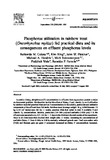Phosphorus utilization in rainbow trout (Oncorhynchus mykiss) fed practical diets and its consequences on effluent phosphorus levels
- Global styles
- MLA
- Vancouver
- Elsevier - Harvard
- APA
- Help

View/
Date
2003Author
Page views
3,546ASFA keyword
AGROVOC keyword
Metadata
Show full item record
Share
Abstract
Excessive dietary phosphorous (P) concentrations in effluents from aquaculture present a major environmental problem. We therefore studied the effect of dietary P and vitamin D3 on P utilization by rainbow trout-fed practical diets and on P concentrations in the soluble, particulate and settleable components of the effluent from fish tanks. Rainbow trout (average weight: 78 g, initial biomass: 13 kg in 0.7 m3 tanks) were fed for 11 weeks, practical diets that varied in total P, available P, and vitamin D3 concentrations. Soluble, particulate (10–200 μm) and settleable (>200 μm) P in the effluent were sampled every 0.5–6 h for 1–3 days in the third and eleventh weeks of the experiment. Trout in all diets more than doubled their weight after 11 weeks. Increasing the concentrations of available dietary P from 0.24% to 0.88% modestly enhanced growth rate. Feed conversion ratio (FCR) and biomass gain per gram P consumed decreased as dietary P concentrations increased. Carcass P, daily P gain, and plasma P concentrations were lower in fish fed with low P diets. Soluble P concentrations in the effluent peaked immediately after and again 4–6 h after feeding, and is a linear function of available dietary P. No soluble P would be produced during consumption of diets containing less than 0.22±0.02% available P. Above this dietary concentration, soluble P would be excreted at 6.9±0.4 mg/day/kg for each 0.1% increase in available dietary P. Particulate P concentrations in the effluent were independent of dietary P concentrations. Settleable, presumably fecal, P concentrations tended to increase with dietary P concentrations. In trout fed with low P (0.24% available P, 0.6% total P) diets, 60% of total dietary P were retained by the fish and the remaining 40% were excreted in the effluent as settleable P (20–30%) and particulate or soluble P (10–20%). In trout fed with high P (0.59–0.88% available P; 0.9–1.2% total P) diets, 30–55% of total dietary P was retained by fish, and the remaining 15–25% appeared in the effluent as settleable P, 20–55% as soluble P, and 5–10% as particulate P. Vitamin D3 did not affect fish growth nor effluent P levels. Physicochemical management of aquaculture effluents should consider the effect of diets on partitioning of effluent P, the peaks of soluble P concentration following feeding, and the contributions of particulate P to total P in the effluent. Increasing our understanding of how dietary P is utilized and is subsequently partitioned in the effluent can contribute significantly towards alleviating this important environmental and industry problem.
Suggested Citation
Coloso, R. M., King, K., Fletcher, J. W., Hendrix, M. A., Subramanyam, M., Weis, P., & Ferraris, R. P. (2003). Phosphorus utilization in rainbow trout (Oncorhynchus mykiss) fed practical diets and its consequences on effluent phosphorus levels. Aquaculture , 220(1-4), 801-820. https://doi.org/10.1016/S0044-8486(02)00403-9
Type
ArticleISSN
0044-8486Collections
- Journal Articles [1258]
Related items
Showing items related by title, author, creator and subject.
-
Nitrogen and phosphorus digestibility and excretion of different-sized groups of milkfish (Chanos chanos Forsskal) fed formulated and natural food-based diets
Sumagaysay-Chavoso, Neila S. (Blackwell Publishing, 2003)This study determined the digestibility of nitrogen and phosphorus, and the excretion rate of different-sized groups of milkfish fed a commercial diet, a SEAFDEC formulated diet or lab-lab (natural food-based diet). Fish ... -
Essentiality of phosphorus, magnesium, iron, zinc, and manganese in milkfish diet
Miñoso, May Grace G.; Borlongan, Ilda G.; Satoh, Shuichi (Japanese Society of Fisheries Science, 1999)Six semi-purified casein based diets were formulated to contain either a complete mineral mixture (control) or mineral premixes from which a specific test mineral was deleted to obtain phosphorus(P)-free, magnesium(Mg)-free, ... -
Nutritional studies on the different life stages of cultured abalone, Haliotis asinina Linne and prawn, Penaeus monodon Fabricius in the Philippines
Bautista-Teruel, Myrna N. (2008-03)Nutrition and feeding studies were conducted on the various life stages of tropical farmed abalone, Haliotis asinina and cultured shrimp, Penaeus monodon. Studies were focused on diet development and feed evaluation with ...



